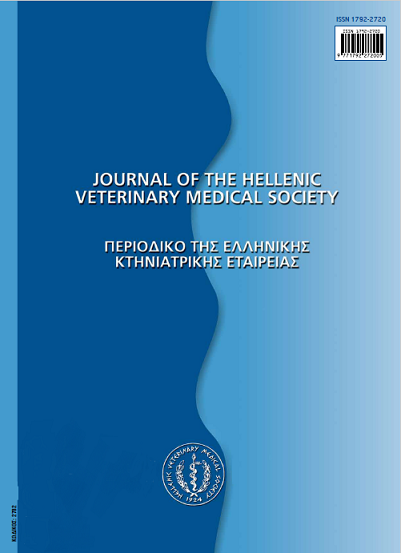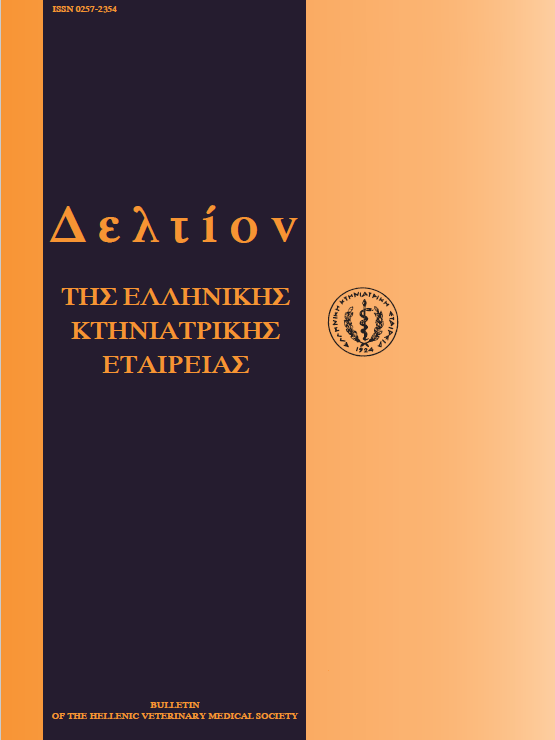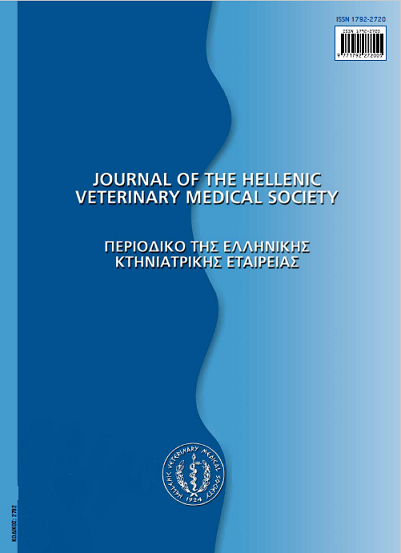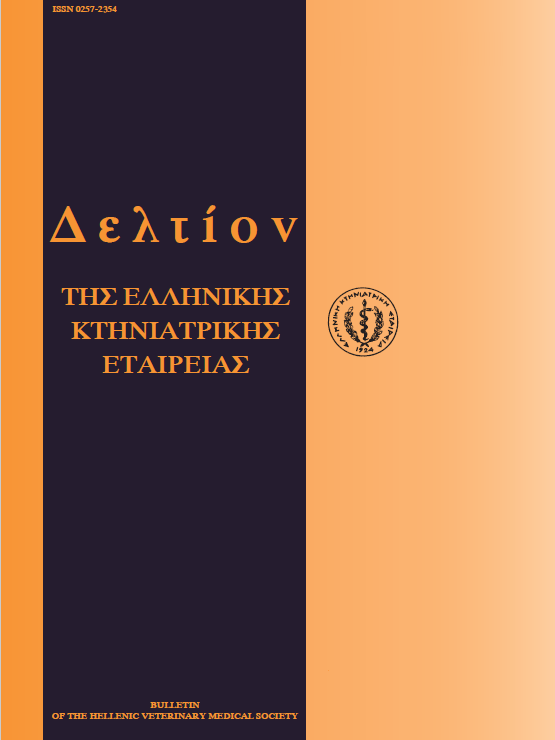Μελέτη πάνω στη λεϊσμανίωση του σκύλου (Leishmania infantum)στην Ελλάδα με βάση ερωτηματολόγιο που απαντήθηκε από κτηνιάτρους ζώων συντροφιάς

Περίληψη
To Νοέμβριο του 2006 στάλθηκαν ερωτηματολόγια με θέμα τη λεισμανιωση του σκύλου (ΛΣ) σε 1.144 Έλληνες κτηνιάτρους που ασχολούνταν αποκλειστικά ή μερικώς με τα ζώα συντροφιάς, για να επιστραφούν τελικά τα 201 (17,6%) από αυτά. Η συχνότητα ανταπόκρισης δεν διέφερε σημαντικά μεταξύ των εννιά γεωγραφικών διαμερισμάτων της χώρας. Η ελάχιστη, μέση και μέγιστη συχνότητα διάγνωσης της ΛΣ σε ετήσια βάση ήταν 0,98%, 3,30% και 7,46%, αντίστοιχα, για το σύνολο της χώρας. Η συχνότητα διάγνωσης ήταν μικρότερη στην Κρήτη, ακολουθούμενη από τα νησιά του Αιγαίου και στη συνέχεια τη Μακεδονία, σε σχέση με την Πελοπόννησο, τη Στερεά Ελλάδα-Εΰβοια και τη Θεσσαλία. Οι περισσότεροι κτηνίατροι (70,4%) εργάζονταν σε περιοχές όπου η ΛΣ ήταν ενδημική και ο αριθμός των νέων περιστατικών και των περιστατικών που βρίσκονται υπό θεραπεία/παρακολούθηση αυξάνονταν ή έμενε στάσιμος τα τελευταία χρόνια. Οι συχνότερες κλινικές εκδηλώσεις ήταν η απώλεια του σωματικού βάρους, η περιφερική λεμφαδενομεγαλια, η αναιμία και η αποφολιδωτική δερματίτιδα με ή χωρίς αλωπεκία, ενώ συχνά η ΛΣ συνυπήρχε με διάφορα άλλα λοιμώδη-παρασιτικά νοσήματα και παθήσεις και ιδιαίτερα την ερλιχιωση και τη διροφιλαριωση. Τα αποτελέσματα των μη ειδικών εργαστηριακών εξετάσεων, όπως οι βιοχημικές, η αιματολογική και η ανάλυση των ούρων έστρεφαν την υποψία στη ΛΣ, η επιβεβαίωση της οποίας βασικά στηριζόταν στις ορολογικές εξετάσεις (εμπορικά kit ταχείας ορολογικής εξέτασης, έμμεσος ανοσοφθορισμός, ELISA) και λιγότερο συχνά στηνάμεση παρασιτολογική εξέταση και την PCR. Για τη θεραπεία του νοσήματος χρησιμοποιούνταν κυρίως η αλλοπουρινόλη και οι πεντασθενεις ενώσεις του αντιμονίου, τις περισσότερες φορές σε συνδυασμό, και λιγότερο συχνά η μετρονιδαζόλη, η κετοκοναζόλη, η αμφοτερικινη Β, οι φθοριοκινολόνες και η αμινοσιδινη. Οι πεντασθενεις ενώσεις του αντιμονίου προκαλούσαν συχνότερα παρενέργειες, για να ακολουθήσει η αμφοτερικινη Β και αρκετά σπανιότερα η αλλοπουρινόλη. Οι παρενέργειες αυτές ήταν η αίτια διακοπής της θεραπείας στο 14% περίπου των περιστατικών. Το σημαντικότερο και ένα από τα συχνότερα κριτήρια για τη διακοπή της θεραπείας ήταν το αρνητικό αποτέλεσμα της ορολογικής εξέτασης, σε συνδυασμό με τη βελτίωσητης κλινικής εικόνας και τα αποτελέσματα των συνήθων εργαστηριακών εξετάσεων, ενώ οι περισσότεροι κτηνίατροι επαναλάμβαναν τη θεραπεία μόνο όταν διαπίστωναν υποτροπή των συμπτωμάτων. Η ευθανασία προτεινόταν από μικρό σχετικά αριθμό κτηνιάτρων, αλλά τελικά κρινόταν ότι είναι αναγκαία στο 10% περίπου των σκύλων που είχαν υποβληθεί σε θεραπεία. Η χρήση εντομοκτόνων ή/και εντομοαπωθητικών ουσιών στους σκύλους ήταν εκτεταμένη και συχνά συνδυαζόταν με άλλα προληπτικά μέτρα, όπως είναι η φύλαξη του ζώου μέσα στο σπίτι τις νυχτερινές ώρες και η λεπτή σίτα στα παράθυρα. Όλοι σχεδόν οι κτηνίατροι ενημέρωναν τους ιδιοκτήτες για τη σχέση της ΛΣ με τη δημόσια υγεία, γεγονός που τις περισσότερες φορές δε λειτουργούσε αποτρεπτικά στην ανάληψη θεραπευτικής προσπάθειας.
Λεπτομέρειες άρθρου
- Πώς να δημιουργήσετε Αναφορές
-
SARIDOMICHELAKIS (Μ.Ν. ΣΑΡΙΔΟΜΙΧΕΛΑΚΗΣ) M. N., KOUTINAS (Α.Φ. ΚΟΥΤΙΝΑΣ) A. F., & BOURDEAU, P. (2017). Μελέτη πάνω στη λεϊσμανίωση του σκύλου (Leishmania infantum)στην Ελλάδα με βάση ερωτηματολόγιο που απαντήθηκε από κτηνιάτρους ζώων συντροφιάς. Περιοδικό της Ελληνικής Κτηνιατρικής Εταιρείας, 60(4), 503–526. https://doi.org/10.12681/jhvms.14938
- Τεύχος
- Τόμ. 60 Αρ. 4 (2009)
- Ενότητα
- Research Articles
Οι συγγραφείς των άρθρων που δημοσιεύονται στο περιοδικό διατηρούν τα δικαιώματα πνευματικής ιδιοκτησίας επί των άρθρων τους, δίνοντας στο περιοδικό το δικαίωμα της πρώτης δημοσίευσης.
Άρθρα που δημοσιεύονται στο περιοδικό διατίθενται με άδεια Creative Commons 4.0 Non Commercial και σύμφωνα με την άδεια μπορούν να χρησιμοποιούνται ελεύθερα, με αναφορά στο/στη συγγραφέα και στην πρώτη δημοσίευση για μη κερδοσκοπικούς σκοπούς.
Οι συγγραφείς μπορούν να καταθέσουν το άρθρο σε ιδρυματικό ή άλλο αποθετήριο ή/και να το δημοσιεύσουν σε άλλη έκδοση, με υποχρεωτική την αναφορά πρώτης δημοσίευσης στο J Hellenic Vet Med Soc
Οι συγγραφείς ενθαρρύνονται να καταθέσουν σε αποθετήριο ή να δημοσιεύσουν την εργασία τους στο διαδίκτυο πριν ή κατά τη διαδικασία υποβολής και αξιολόγησής της.










